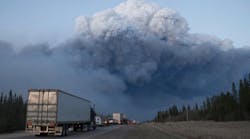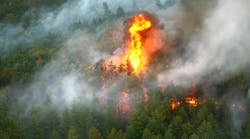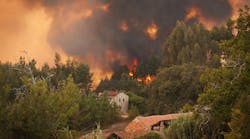I’m working with a group to advise the Alberta government on ways to mitigate the risk of power line-initiated wildfires. With the data we’ve assembled, here are some of the insights and findings.
- The trend for wildfires in the province of Alberta is upward both in the number of starts and area burned
- Power line-initiated wildfires also show an increasing trend
- The worst month for wildfire starts in Alberta is May
- While prevailing winds in the province are northwest and west, during the spring, winds frequently come from the southeast and south
In 2011, we had the Slave Lake fire. One of the key contributing factors to the damage caused by the fire was that there were lines or fingers of fuel leading right into town.
We concluded that the worst-case scenario is a fire start to the south or southeast of a community that has trees (fuel) coming right to the edge of town or worse has fingers of fuelwood probing the community.
The nightmare
A little over a week ago, our worst fears were realized. You’ve probably seen it on the news. A wildfire south of Fort McMurray moved into the city necessitating the evacuation of 88,000 people, for many with just an hour’s notice. No chance to fuel up the car and for some folks, no chance to pick up the kids from school. No chance to find or means to take the family cat along. In some cases, it took days for families to be reunited.
There is one route into and out of Fort McMurray. You may have seen pictures on TV of people fleeing the fire via a completely clogged highway with a background of flames leaping above the tree line.
The losses
Fortunately to date, the loss of life has been limited to one vehicle accident. While there are only preliminary estimates, it has been reported that about 1600 homes have been destroyed by the fire. The airport, water treatment plant and downtown core have escaped damage. The fire has now moved to the east and north of the city. In the news today it was reported that about 300 utility personnel have moved in to assess the integrity of and repair the natural gas system and to rebuild power lines.
The fire has consumed over 165,000 hectares (~410,000 acres) and fire fighters have stated that the fire will probably burn for months. Work to determine the origin location and cause has begun.
As the work of rebuilding begins we will start to get estimates of the costs. Preliminary estimates, while crude, suggest losses will exceed 3 billion and may be as high as 6.5 billion or more. The insurers will be casting about to find from whom they might recover their losses. Should the cause, once determined, point to any entity that would appear to have deep pockets, it must be anticipated that the insurers will aggressively pursue compensation.
There but for the grace of God
At this point, there is nothing to suggest that power lines had anything to do with the Fort McMurray fire start. However, it’s important to ask, "What if?"
I beat this drum rather vigorously a few months back in a series of four articles. You will find links conveniently located here. Please position yourself so should it eventuate that a devastating fire started on your electric system a group of your peers can conclude that everything that could reasonably be done to prevent it, was done.


